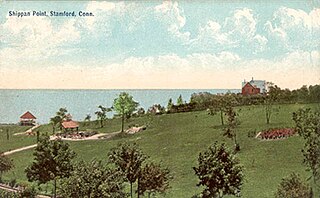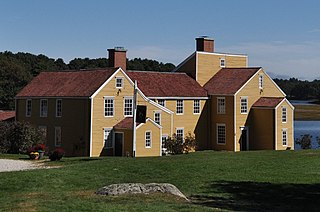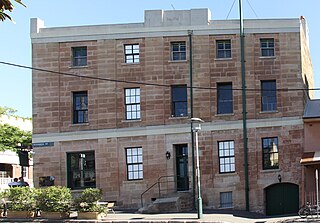
Broomhill and Sharrow Vale — which includes the districts of Broomhill, Broomhall, Crookesmoor, Endcliffe, Sharrow Vale and Tapton Hill — is one of the 28 electoral wards in City of Sheffield, England. The ward was created following the 2015 local government boundary review out of parts of the old Broomhill, Central and Nether Edge wards. It is located in the western part of the city. The population of the Broomhill ward in 2011 was 16,966 people in 5,708 households, covering an area of 2.7 km2. Broomhill & Sharrow Vale is one of the wards that make up the Sheffield Central Parliamentary Constituency.

Shippan Point is the southernmost neighborhood in Stamford, Connecticut, United States, located on a peninsula in Long Island Sound. Street names such as Ocean Drive West and Lighthouse Way reflect the neighborhood's shoreline location. It is one of the wealthiest neighborhoods in the city, with about 1100 homes.

Celtic Manor Resort is a golf, spa and leisure hotel and resort in the city of Newport, South East Wales. It consists of four hotels, a country inn, luxury lodges, two spas, six restaurants, three championship golf courses, two golf and country clubhouses, high ropes courses, adventure golf, laser tag, archery and a multi-purpose conference centre. It was the venue for the 2010 Ryder Cup, the first to be held in Wales, and hosted the 2014 NATO summit.

The Upper Beaches is a neighbourhood in Toronto, Ontario, Canada. It is directly north of the Beaches area. It stretches from Coxwell Avenue in the west to Victoria Park in the east. The southern border is Kingston Road, while the northern boundary is generally considered to be the Canadian National Railway tracks between Gerrard Street and Danforth Avenue. The western part of the area was originally called Norway, and the larger area was once part of the Town of East Toronto. The name "Upper Beaches" was first used by developers and real estate agents around the period of 2001 to 2003 for the selling of houses on redeveloped land in the area, and was used as a marketing tag to attract buyers. The area was never considered part of the Beaches neighbourhood but was close to it. The city's current name for this area is East End Danforth, though that is rarely used. The city also includes the buildings along and just north of Danforth Avenue in the neighbourhood. The western portion between Woodbine Avenue and Coxwell is referred to by the city as Woodbine Corridor.

Cromwell Manor, also known as the David Cromwell House and Joseph Sutherland House, is located on Angola Road in Cornwall, New York, United States, just south of its intersection with US 9W. It consists of four properties, two of which are of note: the 1820 manor house, built in a Greek Revival style and added onto in 1840 and a 1779 cottage known as The Chimneys, the original home on the site.

Wentworth–Coolidge Mansion is a 40-room clapboard house which was built as the home, offices and working farm of colonial Governor Benning Wentworth of New Hampshire. It is located on the water at 375 Little Harbor Road, about two miles southeast of the center of Portsmouth. It is one of the few royal governors' residences to survive almost unchanged. The site is a New Hampshire state park, declared a National Historic Landmark in 1968. Today, the New Hampshire Bureau of Historic Sites manages the site with the assistance of the Wentworth-Coolidge Commission, a group of volunteer civic and business leaders appointed by the Governor.

Belmont Manor House, formally known as Belmont Plantation, is a two-story, five-part Federal mansion in Loudoun County, Virginia, built between the years of 1799–1802 by Ludwell Lee (1760–1836), son of Richard Henry Lee. The land surrounding the mansion, the Belmont property, was handed down to his first wife, Flora Lee, from their grandfather, Thomas Lee.

Flat Top Manor, as it is known to the locals, is also referred to as Moses Cone Manor, Moses Cone Estate, the Moses H. Cone Mansion, or just Flat Top. On the Blue Ridge Parkway it is located at Milepost 294 in Blowing Rock, North Carolina. To most people who travel the Parkway it is simply the Parkway Craft Center, which is the major component of the manor house. It is open to the public from spring through fall and gets over 225,000 visitors annually.

Plumbush is the former house and farm of Robert Parker Parrott , the inventor of the Parrott gun. It is located at the junction of NY 9D and Peekskill Road south of Cold Spring, New York, United States.

The Dodge-Greenleaf House is on NY 211 in Otisville, New York, United States. It was built circa 1855 in the Gothic Revival style. The architect is unknown but it exemplifies contemporary trends in home design popularized by the writings and pattern books of Andrew Jackson Downing of nearby Newburgh, as articulated in the Picturesque mode.

The Michael Salyer Stone House is located on Blue Hill Road in Orangetown, New York, United States. It was built in the late 18th century.

The former Smith Tavern is located on Bedford Road in the hamlet of Armonk, New York, United States. It is a red frame building dating to the late 18th century, one of the few left in a region that has rapidly suburbanized over the past century. The Smith family, for whom it is named, did not build it but owned it for most of the 19th century.

Van Campen's Inn or Isaac Van Campen's Inn is a fieldstone residence that was used as a yaugh house during the American colonial era. Located in Walpack Township, New Jersey along the Delaware River, it is a historic site located along the Old Mine Road in the Delaware Water Gap National Recreation Area. It is operated under a memorandum of understanding between the National Park Service and the Walpack Historical Society, a local non-profit corporation.

The Capt. Thomas Morse Farm is a historic farmhouse on Old Marlborough Road in Dublin, New Hampshire. It is a small 1-1/2 story two-room cottage, similar to other early period Cape style farmhouses in the town and probably built in the late 18th century by one of the town's first settlers. Now a clubhouse for the Dublin Lake Golf Club, it is one of the few buildings from that period to survive. The house was listed on the National Register of Historic Places in 1983. It appears to have been torn down and replaced by a more modern structure.

Sleepy Hollow Country Club is a historic country club in Scarborough-on-Hudson in Briarcliff Manor, New York. The club was founded in 1911, and its clubhouse was known as Woodlea, a 140-room Vanderbilt mansion owned by Colonel Elliott Fitch Shepard and his wife Margaret Louisa Vanderbilt Shepard. It was built in 1892–95 at a cost of $2 million and was designed by the architectural firm McKim, Mead & White; the estate became a contributing property to the Scarborough Historic District in 1984.
Bonnie-Briar County Club is an 18-hole golf course and country club located in the Town of Mamaroneck in Westchester County, New York. The course architect was A. W. Tillinghast, one of the most prolific architects in the history of golf, and designer of nearby Southern Westchester courses including Quaker Ridge Golf Club, Wykagyl Country Club and Winged Foot Golf Club. The course design made excellent use of Bonnie Briar's hilly and low wetland areas, surrounding a wooded interior. A.H. Tull, Geoffrey Cornish and Robert Trent also contributed to various aspects of the course layout, drainage, tees, greens and bunkers.

The Royal Oak Inn is a heritage-listed hotel located on the corner of Windsor Road and Commercial Road, in Rouse Hill in The Hills Shire local government area of New South Wales, Australia. It was built in 1829. It has also been known as the Queens Arms Inn, and is currently known as the Fiddler Hotel. The property is privately owned and was added to the New South Wales State Heritage Register on 2 April 1999.

Duntryleague is a heritage-listed former residential estate and now golf club house and course located at Woodward Road, Orange, City of Orange, New South Wales, Australia. It was built from 1875 to 1890. It is also known as Duntryleague with Lodge, Park, Gates, Stables and Orange Golf Club. The property is owned by The Orange Golf Club Ltd and was added to the New South Wales State Heritage Register on 2 April 1999.

Jarvisfield is a heritage-listed former pastoral property and now golf course at Old Hume Highway, Picton, Wollondilly Shire, New South Wales, Australia. It was designed by William Weaver, architect-engineer, and built from 1815 to 1864. It is also known as Wilton. The property is owned by the Wollondilly Shire Council. It was added to the New South Wales State Heritage Register on 2 April 1999.

The Shipwrights Arms Inn is a heritage-listed residence and former inn and boarding house located at 75 Windmill Street, in the inner city Sydney suburb of Millers Point in the City of Sydney local government area of New South Wales, Australia. It was built from 1832 to 1834. It was added to the New South Wales State Heritage Register on 2 April 1999.





















